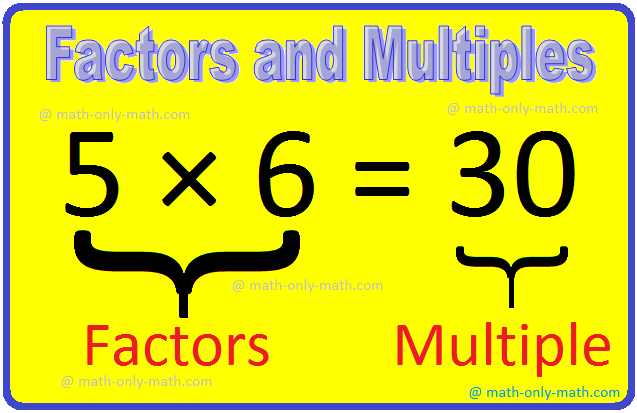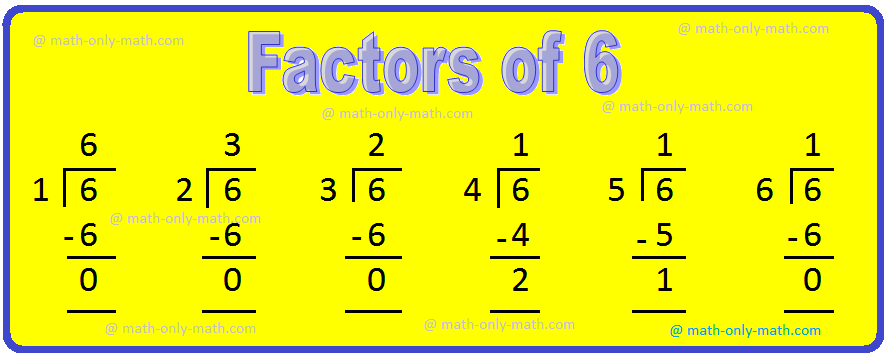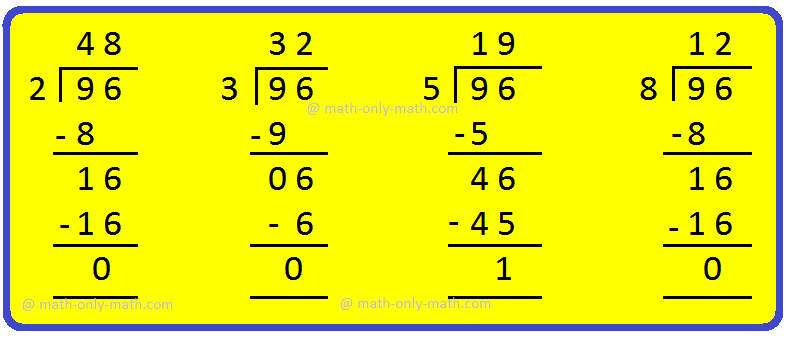Subscribe to our ▶️ YouTube channel 🔴 for the latest videos, updates, and tips.
Multiples and Factors
We will discuss here about multiples and factors and how they are related to each other.
Factors:
Factors of a number are those numbers which can divide the number exactly.
Definition of Factors:
A number which divides a given number exactly is called a factor of the given number. Thus, a factor of a number divides it completely without leaving any remainder.
For example, 1, 2, 3 and 6 are factors of 6.
1, 2 and 4 are factors of 4.
Properties of Factors:
I: 1 is the factor of any/every number.
For example: 1 is a factor of 3 (3 ÷ 1 = 3)
1 is a factor of 15 (15 ÷ 1 = 15)
II: Every non-zero number is factor of itself.
For example: 3 is a factor of 3 (3 ÷ 3 = 1)
15 is a factor of 15 (15 ÷ 15 = 1)
III: 0 has infinite factors. In fact all numbers are factors of zero.
i.e., Every non-zero number is a factor of 0.
For example: 3 and 15 are factors of 0 because
0 ÷ 3 = 0 and 0 ÷ 15 = 0
IV: 0 is not factor of any number because division by 0 is meaningless.
V: The factors of a number are finite but factors of zero are infinite.
VI: Every factor of a number is an exact divisor of that number.
Every number has a fixed number of factors.
For example:
Factors of 24 are 1, 2, 3, 4, 6, 8, 12, and 24.
Factors of 36 are 1, 2, 3, 4, 6, 9, 12, 18, and 36.
Factors of 48 are 1, 2, 3, 4, 6, 8, 12, 16, 24, and 48.
Factors of 30 are 1, 2, 3, 5, 6, 10, 15, and 30.
Factors of 70 are 1, 2, 5, 7, 10, 14, 35, and 70.
Working Rules to Find the Factors of a Number:
To Find the Factors of a Number
Step I: Consider the number, say 'm.
Step II: Find the number 'n' which divides the given number 'm' completely.
Step III: 'n' will be considered as the factor of 'm'.
Solved Examples on Factors:
1. Find the factors of 6.
Solution:
Consider the following divisions:
Here, we observe that 1, 2, 3 and 6 are the only numbers by which the number 6 is divided completely. Hence, 1, 2, 3, 6 are the factors of 6.
Note: Consider the following relationship:
6 = 1 × 6
6 = 2 × 3
i.e., if we multiply two (or more) numbers to get a new numbers, then two numbers are called the factors of the new number.
2. Find out the factors 18, 33 and 36.
Solution:
18 = 1 × 18
= 2 × 9
= 3 × 6
Thus, 1, 2, 3, 6, 9, 18 are factors of 18.
33 = 1 × 33
= 3 × 11
Thus, 1, 3, 11, 33 are factors of 33.
36 = 1 × 36
= 2 × 18
= 3 × 12
= 4 × 9
= 6 × 6
Therefore, 1, 2, 3, 4, 6, 9, 12, 18, 36 are factors of 36.
3. Which of the following is not a factor of 96?
(i) 2
(ii) 3
(iii) 5
(iv) 8
Solution:
We know that a number, which divides another number exactly, is called a factor of the given number.
Now, consider the following divisions:
Hence, 5 is not the factor of 96.
So, the option (iii) is correct.
4. Find whether 53 is a factor of 4578120 or not?
Solution:
First we divide 4578120 by 53
4578120 ÷ 53 = 86379.6226415
Now we see that the result is not a whole number, that means 53 is not a factor of 4578120
Multiples:
A number is called multiple of another if it is exactly divisible by the other number.
Definition of Multiples:
A multiple of a number is a number obtained by multiplying it by a natural number. A number is a multiple of each of its factors.
For example, 8 is a multiple of 4. 6 is multiple of 3. Multiple of any numbers are infinite.
We know counting numbers they are 1, 2, 3, 4, 5, 6, ......
To get multiples of any number, we multiply counting numbers with that number.
For example, to get the list multiples of 3 we need to multiply counting numbers with 3 i.e., 1 × 3 = 3,
2 × 3 = 6,
3 × 3 = 9,
4 × 3 = 12,
5 × 3 = 15 and so on.
So, the multiples of 3 are 3, 6, 9, 12, 15 and so on.
Properties of Multiples:
I: Every number is a multiple of itself
For example: (i) 7 × 1 = 7; 7 is a multiple of 7.
(ii) 4 x 1 = 4; 4 is a multiple of 4.
II: Every number is a multiple of 1.
For example: (i) 1 × 9 = 9; 9 is a multiple of 1.
(ii) 1 × 6 = 6; 6 is a multiple of 1.
III: Every multiple of a number is greater than or equal to that number.
IV: The number of multiples of a given natural number is infinite.
Multiples of any numbers are unlimited.
For example:
Multiples of 2 are 2, 4, 6, 8, 10, 12, 14 etc.
Multiples of 5 are 5, 10, 15, 20, 25, 30 etc.
Multiples of 11 are 11, 22, 33, 44, 55, 66 etc.
Multiples of 8 are 8, 16, 24, 32, 40, 48 etc.
Multiples of 14 are 14, 28, 42, 56, 70, 84 etc.
From the above explanation we understand that how multiples and factors are related to each other.
Suppose for example, 12 = 1 × 12,
12 = 2 × 6,
12 = 3 × 4;
This shows that each of the number, i.e., 1, 2, 3, 4, 6 and 12 are factors of 12.
In other words, we can say that 12 is a multiple of each one of the numbers 1, 2, 3, 4, 6 and 12.
Thus, when a divisor divides a number and there is zero remainder, then the divisor is called the factor of the dividend and dividend is called the multiple of the divisor.
Working Rules to Find the Multiple of a Number:
To find the Multiple of a Number
Step I: Consider the number, say 'p'
Step II: Multiply the given number 'p' by any natural number.
Step III: The number obtained on multiplying are multiples of the given number.
Solved Examples on Multiples:
1. Find out the first five multiples of:
(i) 4; (ii) 6; (iii) 11
Solution:
(i) We get.
4 × 1 = 4
4 × 2 = 8
4 × 3 = 12
4 × 4 = 16
4 × 5 = 20
Therefore, 4, 8, 12, 16, 20 are the first five multiples of 4.
(ii) We get,
6 × 1 = 6
6 × 2 = 12
6 × 3 = 18
6 × 4 = 24
6 × 5 = 30
Therefore, 6, 12, 18, 24 and 30 are the first five multiples of 6.
(iii) We get,
11 × 2 = 22
11 × 3 = 33
11 × 4 = 44
11 × 5 = 55
Therefore, 11, 22, 33, 44 and 55 are the first five multiples of 11.
2. The first 9th multiple of 15 is
(i) 45
(ii) 15
(iii) 135
(iv) 105
Solution:
We get, 15 × 9 = 135
So, the option (iii) is correct.
3. Is 1207 a multiple of 17?
Solution:
If we divide 1207 by 17 and the quotient is a whole number without a
remainder, then 1207 is divisible by 17.
1207 ÷ 17 = 71 × 17 + 0
Here quotient = 71
Remainder = 0
Now we see that 1207 is divisible by 17.
Therefore, 1207 a is multiple of 17.
REMEMBER:
Special Number'zero'
● Write multiples of 0.
● Do you think 1 is a multiple of 0?
● How many multiples do zero have?
HINT: If we multiply 0 with any natural number we always get zero.
So multiple of zero is only 0.
5th Grade Math Problems
From Multiples And Factors to HOME PAGE
Didn't find what you were looking for? Or want to know more information about Math Only Math. Use this Google Search to find what you need.





New! Comments
Have your say about what you just read! Leave me a comment in the box below. Ask a Question or Answer a Question.